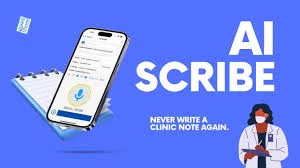🔬 AI in Medical Documentation: Will Human Scribes Evolve or Vanish? (2025 Deep Dive)
🧠 Introduction: A Healthcare Career at the Crossroads
Imagine this: A physician walks into the exam room. Instead of typing on a screen or narrating to a human scribe, they speak casually—and an AI assistant captures every detail, codes it correctly, and files it instantly.
Science fiction? Not anymore.
In 2025, Artificial Intelligence (AI) is rapidly transforming how healthcare is delivered—and documented. With AI-based scribing software now capable of listening, learning, and typing faster than a human, many are asking:
“Will AI replace human medical scribes?”
The answer is not as simple as yes or no.
In this deep dive, we explore the real picture—the promise, the limitations, and the evolving role of human medical scribes in a world increasingly run by algorithms.
🤖 What Is AI Medical Scribing?
AI medical scribing involves using software powered by natural language processing (NLP), machine learning (ML), and speech recognition to transcribe, structure, and input clinical data during a patient encounter.
Some popular tools:
-
Suki AI
-
Augmedix
-
DeepScribe
-
Google’s MedLM
-
Nuance DAX (by Microsoft)
These platforms promise:
-
Real-time documentation
-
Minimal physician effort
-
HIPAA-compliant integration with EHRs
-
Reduced burnout
Sounds perfect? Not quite.
🧑⚕️ What Do Human Medical Scribes Do—That AI Still Can’t?
Despite rapid tech gains, human scribes remain vital. Why?
🧠 1. Contextual Understanding
AI may capture “patient has chest pain,” but a human scribe can note:
“Patient describes pain after heavy meal, anxious about heart issues.”
Nuance, emotional cues, and patient behavior are still better interpreted by humans.
📋 2. Workflow Adaptability
Doctors differ. Some dictate. Others jump between thoughts. Some abbreviate. Human scribes adapt instantly. AI? Needs retraining or fails.
🔐 3. Ethical Decision Support
Doctors often use scribes to note subtle decisions:
“I suspect early-stage Parkinson’s, but I’m not mentioning it yet.”
AI may transcribe everything without discretion, creating legal or emotional risks.
🧩 4. Administrative & Real-Time Support
Human scribes:
-
Queue labs
-
Fetch reports
-
Send referrals
-
Coordinate billing codes
They’re not just passive recorders—they’re clinical assistants.
⚖️ AI vs Human Scribes: Side-by-Side Snapshot
| Feature | AI-Based Scribe | Human Scribe |
|---|---|---|
| Speed | ✅ Fast, scalable | ✅ Trained to multitask |
| Accuracy (structured) | ✅ 90%+ (with training) | ✅ 95%+ (with context awareness) |
| Emotional nuance | ❌ Often misses | ✅ Always interprets |
| Decision filtering | ❌ Records everything | ✅ Notes only what's needed |
| Cost | ✅ Cheaper at scale | ❌ Higher training + labor cost |
| Flexibility | ❌ Limited | ✅ Highly adaptive |
| EHR integration | ✅ Seamless with APIs | ✅ Familiar with multiple EHRs |
🌍 Global Adoption: AI & Human Collaboration
Healthcare providers worldwide are not replacing scribes but pairing them with AI to improve speed and reduce fatigue.
🏥 Real-World Models:
-
🧠 AI drafts the notes → 🧑💻 Human scribe reviews, corrects, finalizes
-
🤝 AI handles routine dictation → Human scribe handles logic & judgment
-
📊 AI captures voice → Human adds structure, codes, and compliance
This collaborative workflow is gaining traction in the U.S., UAE, and now in India’s fast-growing medical scribing industry.
🇮🇳 India’s Outlook: Risk or Opportunity?
India’s medical scribing sector is booming—with hundreds of institutes and companies offering training, and thousands of jobs supporting global hospitals.
But with AI coming in:
-
📉 Will hiring slow down?
-
🧠 Will only high-skill scribes survive?
-
🤔 Should students still pursue this career?
Yes, with upskilling.
India is uniquely positioned to lead the hybrid model:
-
Fluent English speakers
-
Affordable talent pool
-
Massive healthcare demand
-
Tech adaptability
🎓 What Future Scribes Must Learn (2025+)
To stay relevant, medical scribes must evolve beyond typing:
✅ Core Skillsets:
-
Medical coding & compliance
-
Advanced anatomy & pharmacology
-
EHR systems (Epic, Cerner, Athena)
-
Voice & AI-based workflows
-
Data quality & auditing
-
Real-time team collaboration
“Don’t just learn how to scribe. Learn how to manage what AI transcribes.”
📈 Career Outlook: Still Promising—but Different
Medical scribing is no longer just a stepping-stone to MBBS—it’s a real career with real growth.
🔮 Emerging Roles:
-
AI Medical Documentation Specialist
-
Healthcare Data Quality Analyst
-
EHR Workflow Architect
-
Voice-AI Support Coordinator
-
Remote Clinical Documentation Reviewer
In 2025, the best scribes are becoming knowledge managers in the healthcare pipeline.
🧘 Is This Career Still Worth It?
✅ If you’re passionate about medicine
✅ If you want to work in healthcare from home
✅ If you're willing to adapt, learn tech, and grow
Then yes, this career is not disappearing—it’s evolving.
What’s going away are low-effort, minimal-skill jobs.
📲 How to Use This Article on Social Media
📸 Instagram Reel Caption:
“AI is changing medical scribing—but human judgment is still priceless. Learn what’s next in 2025. #MediOwlScript #AIvsHumanScribes #HealthcareCareers”
📢 LinkedIn Post Hook:
“AI won't replace medical scribes. But it will replace those who don't evolve. Read this before you write off your healthcare future.”
💬 Final Word: Humans Still Matter—Now More Than Ever
The future is not humans vs AI—it’s humans with AI.
In the hands of a trained, thoughtful, and tech-savvy human scribe, AI becomes a tool—not a threat.
Whether you're a student, a working scribe, or a hospital leader, remember:
People heal people. Technology only supports them.
In 2025, let’s not fear AI. Let’s train it, tame it, and use it to serve better care.
“For a detailed strategy on thriving as a scribe in the AI era, read this follow-up: [AI in Medical Scribing – How to Adapt, Upskill & Succeed in 2025]”

Comments
Post a Comment